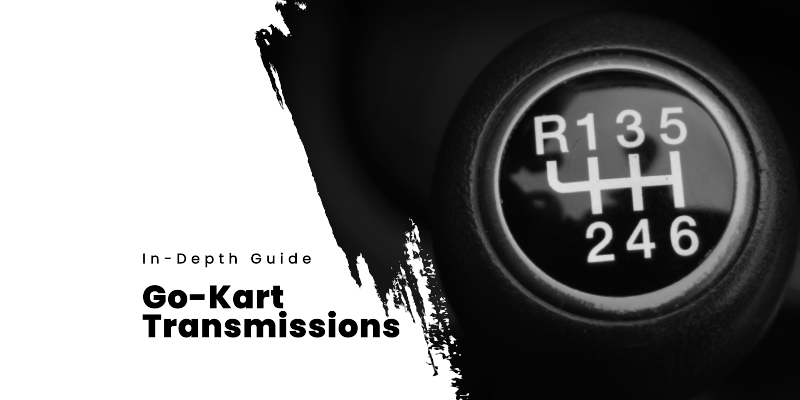Get ready to rev up your engines, go-kart enthusiasts! Welcome to the exciting world of go-kart transmissions, where speed meets control in a thrilling race to the finish line. In this comprehensive guide, we’ll take you through the ins and outs of the different types of go-kart transmissions.
Whether you’re a casual karting fan or an adrenaline-pumping racer, understanding go-kart transmissions is essential to mastering the art of go-karting. So, buckle up and dive into these marvelous machines’ fascinating mechanics!
| Key Takeaways |
|---|
| Go-kart transmissions come in three main types: direct drive, automatic (clutch and torque converter), and manual (gearbox), each with unique benefits and suited for specific applications. |
| Direct drive go-karts are simple, affordable, and efficient, but lack variable gear ratios and idling capabilities. |
| Automatic transmissions (clutch and torque converter) offer the ability to idle and adjust gear ratios, but require more frequent maintenance than direct drive systems. |
| Manual transmissions are mainly used in professional racing karts, providing precise control and multiple gear ratios, but are more expensive and complex. |
| Proper maintenance of go-kart transmissions, depending on the type, is crucial for their longevity and reliability, ensuring optimal performance and an enjoyable driving experience. |
Related Article: How to Install a Reverse Gearbox on a Go-Kart
Types of Go-Kart Transmissions
A go-kart transmission is a crucial component that transfers the engine’s power to the rear axle and wheels. There are three main types of transmissions used in go-karting:
- Direct Drive (No Transmission)
- Automatic Transmission (Clutch and Torque Converter)
- Manual Transmission (Gear Box)
Each type is suited for specific go-karting applications and offers unique benefits. This article will explore each transmission type, its functionalities, and appropriate use cases.
| Transmission Type | Type | System | Gear Ratio | Efficiency | Torque | Cost |
|---|---|---|---|---|---|---|
| Clutch | Automatic | Chain | Fixed | <100% | High-End | Low to High |
| Torque Converter | Automatic | Belt | Variable | 80% | Low-End | Low to Medium |
| Gearbox | Manual | Chain/Clutch | Selective | <100% | High-End | Very High |
Direct Drive (No Transmission)
Direct drive is the simplest form of go-kart transmission. It involves connecting the drive sprocket directly to the rear axle without intervening gears, chains, or belts. As such, the wheels receive power directly from the engine. Direct-drive go-karts are generally the most affordable and easiest to build, requiring fewer components.
However, there are some drawbacks. Direct-drive go-karts lack idling capabilities and variable gear ratios and can wear out parts more quickly.
Here’s a step-by-step explanation of how to direct drive transmission works in a go-kart:
- Engine: The go-kart engine generates power, typically through a small gas-powered or electric motor. The engine’s output shaft is connected to a sprocket.
- Chain: A chain transfers power from the engine sprocket to the rear axle sprocket. The chain wraps around both sprockets, directly linking the engine and the rear wheels.
- Rear axle sprocket: The rear axle sprocket is connected to the rear axle, which supports the rear wheels. As the engine turns, the output shaft sprocket and the chain turn the rear axle sprocket, causing the rear axle to rotate.
- Rear axle: The rear axle is a solid metal rod that spans the width of the go-kart, connecting both rear wheels. When the rear axle rotates, both rear wheels turn at the same speed, propelling the go-kart forward
Pros
- Simple design
- Efficient power transfer
- Lightweight
- Cost-effective
- Quick acceleration
Cons
- No gears
- No clutch
- Limited torque control
- Prone to overheating
Automatic Transmission
Automatic go-kart transmissions come in two main types – clutch and torque converter. Both types allow the kart to stay idle, operate at different speeds, and automatically adjust the gear ratio depending on the RPM (revolutions per minute).
Clutch Transmission
Go-kart clutch transmissions involve one or more centrifugal clutches engaged with the engine crankshaft. As the engine speeds up, centrifugal forces cause the clutch shoes to expand outward, engaging the clutch and transferring power to the axle. Clutches come in various types, including:
- Centrifugal Clutches (most common)
- Belt Clutches
- Electric Clutches
- Hydraulic Clutches
Clutch transmissions are ideal for racing go-karts because they are lightweight and straightforward. However, they can wear out quickly due to slipping and lack a variable gear ratio.
Pros
- Ideal for racing go-karts
- Affordable
- Allows engine to idle
- Easy to set up
Cons
- Can wear due to slipping
- No variable gear ratio
Torque Converter Transmission
A torque converter transmission uses a fluid coupling mechanism to transfer power from the engine to the rear axle. It consists of a driver pulley and a driven pulley connected by a V-belt. The torque converter enables smooth acceleration, especially when driving off-road or carrying heavy loads at low RPM.
Torque converters are commonly used in off-road go-karts and provide a variable gear ratio, making it easier to drive on diverse terrains. However, they require more frequent maintenance, such as belt replacements, and offer lower efficiency than clutch transmissions.
Pros
- Suitable for off-road go-karts
- Inexpensive
- Allows engine to idle
- Less prone to wear
- Variable gear ratio
Cons
- Requires belt replacements
- Spring adjustments may be required
- Lower efficiency
Manual Transmission (Gear Box)
Manual transmissions, called shifter karts, allow drivers to switch between gears. This, in turn, offers more control in acceleration and deceleration. Go-kart manual transmissions rely on a gearbox, usually ranging from 4 to 6 gears, connected to the engine utilizing a sequential shifter.
Manual transmissions are mainly used in professional racing karts and provide a more engaging and skill-based driving experience. However, they can be complex, require regular maintenance, and are more expensive to build.
Pros
- Utilized in shifter karts
- Maximizes engine performance
- Multiple gear ratios
- Ability to manually change gears
Cons
- Expensive
- Heavy maintenance
- Complex installation
How to Choose the Right Go-Kart Transmission
To select the most appropriate go-kart transmission, consider the intended purpose and usage of your go-kart.
- Direct drive is suitable for leisure go-karting due to its simplicity and affordability.
- Automatic transmissions, including clutch and torque converter transmissions, are well-suited for racing and off-road go-karting, as they provide versatility and adaptability.
- Finally, consider manual transmissions for professional racing, where precise control and performance are crucial.
Choosing the right go-kart transmission depends on the intended purpose and usage. Evaluate your go-karting needs and preferences to select the most appropriate transmission for your requirements.
Common Transmission-Related Problems and Their Solutions
Go-kart transmissions may encounter several common issues depending on the type. Proper maintenance and timely attention can help mitigate these problems:
- Slipping clutches: Often resulting from excessive wear or improper adjustment, slipping clutches can lead to inconsistent power transfer and reduced performance. Addressing this issue involves inspecting and adjusting the clutch components as necessary.
- Worn or damaged belts: In torque converter transmissions, worn or damaged belts contribute to reduced efficiency and risk of sudden failure. Regular inspection and timely replacement of belts can prevent this problem.
- Difficulty shifting gears: Difficultly shifting gears can be due to worn gearbox components or a misaligned shift linkage for manual transmissions. Resolving this issue may require replacing or repairing the affected parts and ensuring proper alignment.
By addressing these common issues, you can ensure a smooth and reliable go-kart driving experience.
Maintenance Tips for Go-Kart Transmissions
Proper maintenance of your go-kart transmission is essential for its reliability and longevity. Routinely inspect and clean the components, replacing damaged or worn-out parts when necessary. Follow maintenance tips specific to each transmission type, such as:
- Inspecting and replacing worn belts in torque converter transmissions
- Changing gearbox oil in manual transmissions
- Greasing and adjusting clutches in clutch transmissions
- Straightening and aligning drivetrain components in direct drive systems
Regularly maintaining your go-kart transmission will ensure optimal performance and prevent costly repairs or replacements down the line. Familiarize yourself with the maintenance needs of your go-kart’s transmission type and establish a routine inspection schedule. Doing so will keep your go-kart running smoothly and extend its life, allowing you to enjoy the thrill of go-karting for years.
Conclusion
The right go-kart transmission depends on your kart’s purpose and your desired driving experience. By understanding each transmission type and its functionalities, you can make an educated decision and maintain your kart for optimal performance. Remember to consult expert resources, like those found at Go-Kart Life, to help you make the right choice and ensure your go-kart runs smoothly for years.
You can learn more about transmissions here.
Frequently Asked Questions
The most reliable transmission option for go-karts is often a torque converter. Torque converters provide better acceleration and a smoother ride than centrifugal clutches, making them a popular choice among go-kart enthusiasts.
Yes, it is possible to add a transmission to a go-kart. Installing a transmission allows for better control over speed and acceleration, ultimately enhancing your go-kart’s performance.
Yes, you can upgrade your go-kart’s transmission. However, be prepared for potentially higher costs and a more complex installation process, especially if upgrading to a manual transmission.
A go-kart clutch is a non-variable automatic transmission with a fixed gear ratio. At the same time, a torque converter is a variable transmission with a changing gear ratio based on the engine’s RPM. Clutches are more suitable for high-speed applications and racing, while torque converters perform better under heavy loads and on inclined surfaces.
The frequency of maintenance depends on the type of transmission and its usage. Regular maintenance, such as cleaning and lubrication, should be performed every few rides. More intensive maintenance, such as replacing worn parts or adjusting spring tension, should be performed based on your kart’s performance and observations. Always consult the manufacturer’s recommendations for specific maintenance guidelines.

Goran, an experienced go-kart racer, fuels GoKartLife.com with his passion and expertise. He offers valuable insights and tips for fellow enthusiasts, fostering the growth of the go-kart community. Join Goran at GoKartLife.com and immerse yourself in this exhilarating sport.
Last modified: December 12, 2024



